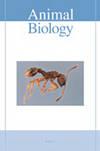氟虫腈生长调节剂在大花田鼠成虫体内的细胞机制
IF 0.9
4区 生物学
Q2 ZOOLOGY
引用次数: 0
摘要
生长调节杀虫剂在未成熟时用于几种棉花害虫,尽管没有登记用于大红掌,但它们的使用使成年棉花的种群数量减少,令人满意。然而,目前尚不清楚这种减少涉及哪些机制。因此,我们研究了哪些组织和细胞变化可能参与这一过程。用用鲁芬脲(4ml商业产品/l)处理的花蕾喂养成虫24小时。然后,在24小时和48小时后评估性腺的组织学、氧化应激和细胞凋亡。我们的研究表明,鲁芬脲激活了A.grandis的氧化应激途径,在细胞水平上引起显著变化。这些变化可能是由刺激氧离子、自由基和过氧化氢的产生引起的,导致处理后48小时脂质过氧化增加。这种害虫性腺中存在的组织病理学证实了这些影响,如卵泡细胞上皮的紊乱、卵黄的减少、生发囊泡的消失、精子束和囊肿的减少。这种改变损害了性腺,损害了组织的稳态。结论是,在田间管理害虫时,这些因素加在一起会导致理想的种群减少,因为目的是将其控制在控制水平以下。除了这种理想的效果外,值得注意的是,与其他常用产品相比,鲁芬脲更安全,这也是其使用非常有趣的另一个特点。本文章由计算机程序翻译,如有差异,请以英文原文为准。
Cellular mechanisms of the lufenuron growth regulator in adults of Anthonomus grandis (Coleoptera: Curculionidae)
Growth-regulating insecticides are used for several cotton pests when immature, and although not registered for Anthonomus grandis, their use causes a satisfactory population reduction in adults. However, it is not known which mechanisms are involved in this reduction. Thus, we studied which tissue and cellular changes may be involved in this process. Adults were fed with flower buds treated with lufenuron (4 ml commercial product /l) for 24 h. Then, the histology of the gonads, oxidative stress and apoptosis were evaluated after periods of 24 h and 48 h. Our study revealed that lufenuron activates the oxidative stress pathway in A. grandis, causing significant changes at the cellular level. These changes may have been caused by stimulation of the production of oxygen ions, free radicals and hydrogen peroxides, resulting in an increase in lipid peroxidation 48 h after treatment. These effects were confirmed by the presence of histopathologies in the gonads of this pest such as disorganization of the follicular cell epithelium, reduction of the yolk, disappearance of the germinal vesicle, reduction of sperm bundles and cysts. Such alterations injured the gonads and impaired tissue homeostasis. It is concluded that together these factors lead to a desirable population reduction when it comes to managing the pest in the field, because the aim is to keep it below the control level. In addition to this desired effect, it is worth noting that lufenuron is safer when compared to other commonly used products, another feature that makes its use quite interesting.
求助全文
通过发布文献求助,成功后即可免费获取论文全文。
去求助
来源期刊

Animal Biology
生物-动物学
CiteScore
2.10
自引率
0.00%
发文量
34
审稿时长
3 months
期刊介绍:
Animal Biology publishes high quality papers and focuses on integration of the various disciplines within the broad field of zoology. These disciplines include behaviour, developmental biology, ecology, endocrinology, evolutionary biology, genomics, morphology, neurobiology, physiology, systematics and theoretical biology. Purely descriptive papers will not be considered for publication.
Animal Biology is the official journal of the Royal Dutch Zoological Society since its foundation in 1872. The journal was initially called Archives Néerlandaises de Zoologie, which was changed in 1952 to Netherlands Journal of Zoology, the current name was established in 2003.
 求助内容:
求助内容: 应助结果提醒方式:
应助结果提醒方式:


